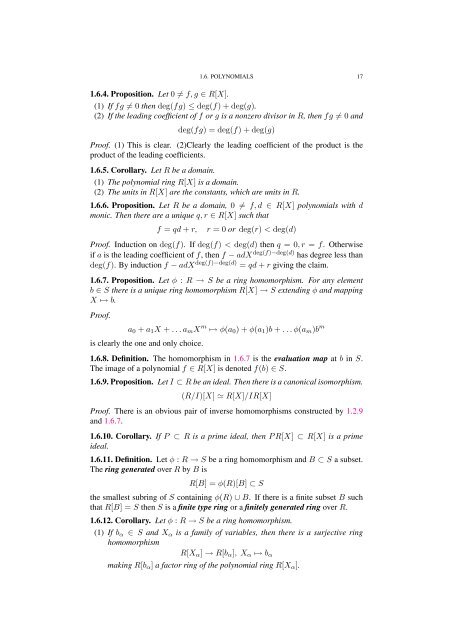Commutative algebra - Department of Mathematical Sciences - old ...
Commutative algebra - Department of Mathematical Sciences - old ...
Commutative algebra - Department of Mathematical Sciences - old ...
Create successful ePaper yourself
Turn your PDF publications into a flip-book with our unique Google optimized e-Paper software.
1.6. POLYNOMIALS 17<br />
1.6.4. Proposition. Let 0 = f, g ∈ R[X].<br />
(1) If fg = 0 then deg(fg) ≤ deg(f) + deg(g).<br />
(2) If the leading coefficient <strong>of</strong> f or g is a nonzero divisor in R, then fg = 0 and<br />
deg(fg) = deg(f) + deg(g)<br />
Pro<strong>of</strong>. (1) This is clear. (2)Clearly the leading coefficient <strong>of</strong> the product is the<br />
product <strong>of</strong> the leading coefficients.<br />
1.6.5. Corollary. Let R be a domain.<br />
(1) The polynomial ring R[X] is a domain.<br />
(2) The units in R[X] are the constants, which are units in R.<br />
1.6.6. Proposition. Let R be a domain, 0 = f, d ∈ R[X] polynomials with d<br />
monic. Then there are a unique q, r ∈ R[X] such that<br />
f = qd + r, r = 0 or deg(r) < deg(d)<br />
Pro<strong>of</strong>. Induction on deg(f). If deg(f) < deg(d) then q = 0, r = f. Otherwise<br />
if a is the leading coefficient <strong>of</strong> f, then f − adX deg(f)−deg(d) has degree less than<br />
deg(f). By induction f − adX deg(f)−deg(d) = qd + r giving the claim.<br />
1.6.7. Proposition. Let φ : R → S be a ring homomorphism. For any element<br />
b ∈ S there is a unique ring homomorphism R[X] → S extending φ and mapping<br />
X ↦→ b.<br />
Pro<strong>of</strong>.<br />
a0 + a1X + . . . amX m ↦→ φ(a0) + φ(a1)b + . . . φ(am)b m<br />
is clearly the one and only choice.<br />
1.6.8. Definition. The homomorphism in 1.6.7 is the evaluation map at b in S.<br />
The image <strong>of</strong> a polynomial f ∈ R[X] is denoted f(b) ∈ S.<br />
1.6.9. Proposition. Let I ⊂ R be an ideal. Then there is a canonical isomorphism.<br />
(R/I)[X] R[X]/IR[X]<br />
Pro<strong>of</strong>. There is an obvious pair <strong>of</strong> inverse homomorphisms constructed by 1.2.9<br />
and 1.6.7.<br />
1.6.10. Corollary. If P ⊂ R is a prime ideal, then P R[X] ⊂ R[X] is a prime<br />
ideal.<br />
1.6.11. Definition. Let φ : R → S be a ring homomorphism and B ⊂ S a subset.<br />
The ring generated over R by B is<br />
R[B] = φ(R)[B] ⊂ S<br />
the smallest subring <strong>of</strong> S containing φ(R) ∪ B. If there is a finite subset B such<br />
that R[B] = S then S is a finite type ring or a finitely generated ring over R.<br />
1.6.12. Corollary. Let φ : R → S be a ring homomorphism.<br />
(1) If bα ∈ S and Xα is a family <strong>of</strong> variables, then there is a surjective ring<br />
homomorphism<br />
R[Xα] → R[bα], Xα ↦→ bα<br />
making R[bα] a factor ring <strong>of</strong> the polynomial ring R[Xα].
















